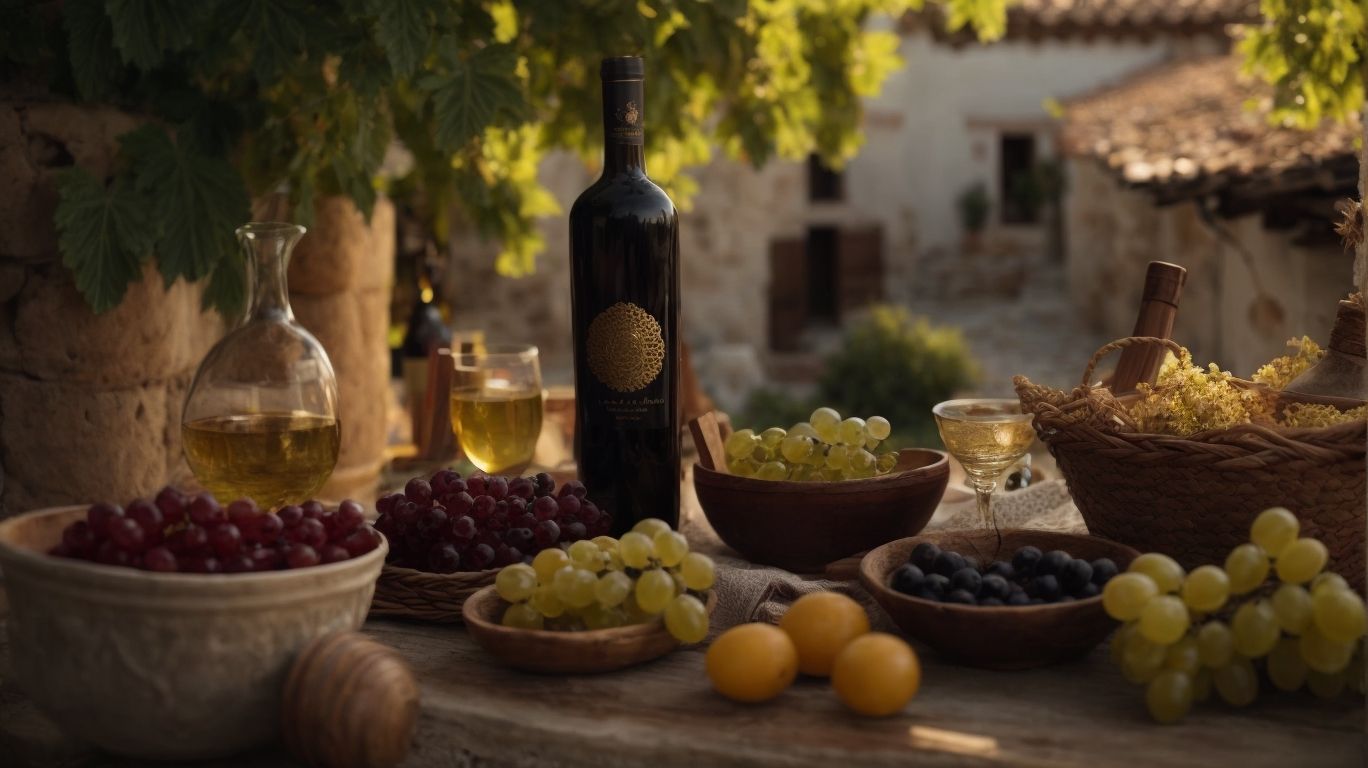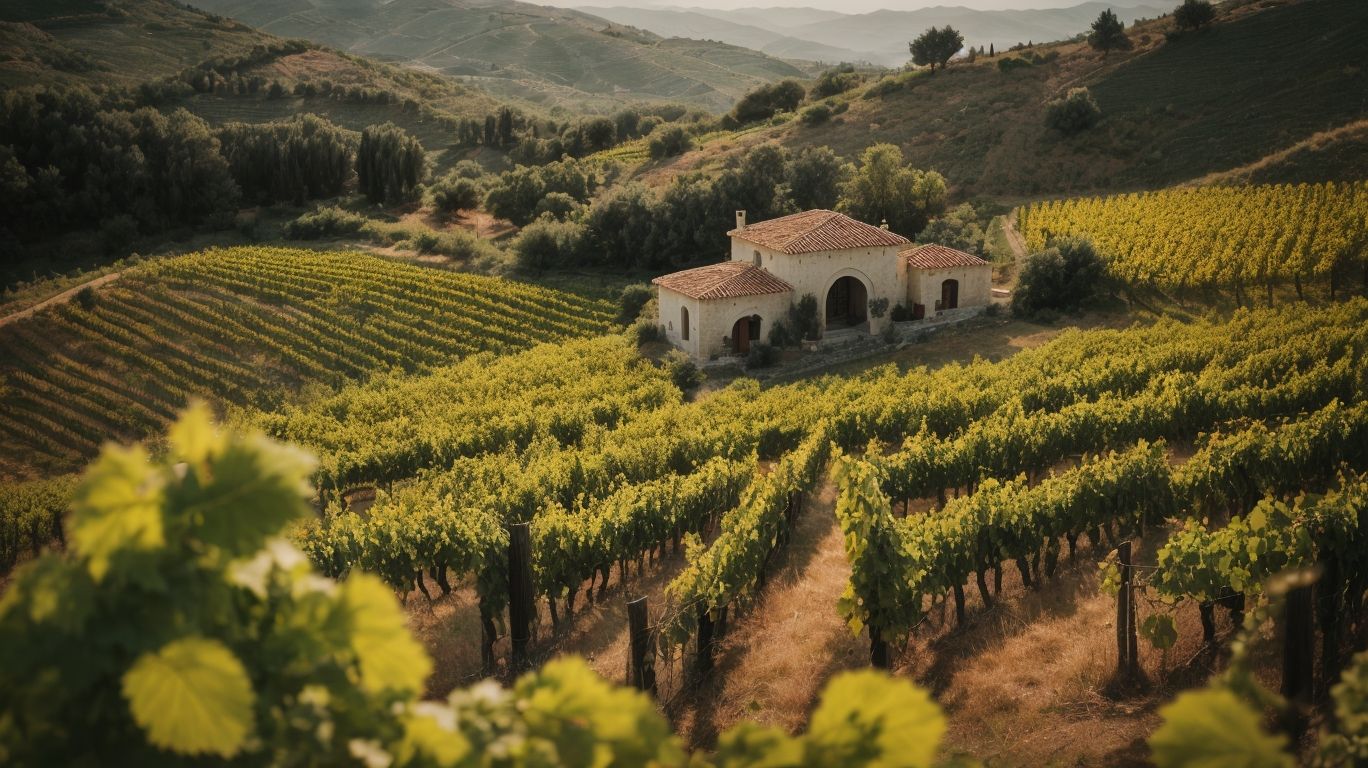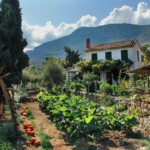
Retsina, a unique and traditional wine from Greece, holds a rich history and distinctive flavor that sets it apart from other wines. In this article, we will explore the origins, tradition, making process, characteristics, food pairings, regions, and popular brands of Retsina wine.
Retsina is a Greek wine that is known for its distinctive resinous flavor. The wine has a long-standing history in Greece, dating back thousands of years. It is believed to have originated in ancient times, where resin was used as a sealant for wooden barrels. Over time, the resin infused into the wine, giving it a unique taste.
The resinous tradition is the hallmark of Retsina wine. The addition of resin to the wine serves multiple purposes. First, it acts as a preservative, enhancing the wine’s longevity. Second, it imparts a distinctive flavor profile that is often described as herbal, pine-like, and slightly resinous. This flavor can vary depending on the type of resin used and the winemaker’s techniques.
Adding resin to the wine is a meticulous process. Typically, small pieces of pine resin are added to the grape must during fermentation, allowing the resin to infuse into the wine. The length of time the resin is in contact with the wine impacts the level of resinous flavor.
Various grape varieties are used in the production of Retsina wine, including Savatiano and Roditis. These grapes are well-suited to the Greek climate and contribute to the wine’s unique characteristics.
When it comes to aroma and flavor, Retsina wine offers a distinct profile. The resinous notes blend with fruity and herbal undertones, creating a complex and intriguing experience for the palate.
Retsina wine’s distinctive characteristics make it a perfect companion for traditional Greek dishes. Classic pairings include seafood, grilled meats, Greek salads, and mezes. However, modern culinary trends have expanded the horizons of Retsina wine pairing, allowing for innovative and unexpected combinations.
Different regions in Greece are known for producing Retsina wine. Each region brings its own unique terroir and winemaking techniques, resulting in subtle variations in flavor and character.
Some well-known Retsina wine brands include Kourtaki, Tetramythos, and Gaia. These brands showcase the tradition and expertise behind Retsina wine production, while also embracing new trends and variations.
Key takeaways:
- The origins of Retsina: Retsina wine is a traditional Greek wine that has been made for centuries. It is known for its unique flavor, which is achieved by adding resin during the fermentation process.
- The role of resin: Resin is added to Retsina wine to create a distinctive flavor profile. The resin comes from the Aleppo pine tree and imparts a piney, herbal taste to the wine. It also acts as a preservative, helping to extend the wine’s shelf life.
- The Greek wine regions for Retsina: Retsina wine is primarily produced in the regions of Attica and Sterea Ellada in Greece. These regions have a long history of winemaking and are known for their unique terroir, which contributes to the character of the Retsina wine.
What is Retsina?

Photo Credits: Cookingwithgreekpeople.Com by Jose Walker
Retsina is a traditional Greek wine that is known for its unique taste. What makes Retsina special is the addition of resin from pine trees during fermentation. This ancient winemaking method is what gives Retsina its distinct flavor and aroma. The resin not only acts as a natural preservative but also imparts a subtle pine-like character to the wine. So, what is Retsina exactly? Well, it is a type of Greek wine that is enjoyed alongside delicious Greek cuisine. It pairs particularly well with dishes like grilled seafood and mezes. Interestingly, Retsina has a rich history dating back over 2,000 years. In fact, it was originally sealed with resin to protect it during transport.
What is the Origin of Retsina Wine?
What is the Origin of Retsina Wine?
Retsina wine traces its origins back thousands of years to ancient Greece. The unique taste of retsina can be attributed to the ancient practice of using resin from Aleppo pine trees to seal and preserve the wine. This tradition arose out of necessity, as glass or cork bottle stoppers were not available during that time. The resin infusion gave the wine a distinctive flavor and aroma, which has since become a defining characteristic of retsina. Even today, retsina is produced using this ancient technique, upholding its status as an authentic Greek wine. For an immersive experience, it is recommended to pair retsina with traditional Greek dishes such as grilled fish or moussaka.
The Resinous Tradition

Photo Credits: Cookingwithgreekpeople.Com by Jeffrey Wright
The Resinous Tradition in Greece’s Retsina wine is a one-of-a-kind winemaking process that has been practiced since ancient times. This traditional technique involves adding pine resin to the must during fermentation, which imparts a unique flavor and aroma to the wine. The distinct piney notes make this wine a perfect pairing for Greek cuisine, especially seafood dishes and grilled meats. Despite the passage of time, only a few wineries in Greece continue to maintain this ancient tradition, ensuring that the art of Retsina wine production stays alive. Immerse yourself in the world of Retsina wine and experience the remarkable history behind this ancient and exceptional tradition.
| Ancient Tradition | Distinct Flavor | Pairs with Greek Cuisine | Maintained by Few Wineries |
Why is Resin Used in Retsina Wine?
Resin is used in Retsina wine to impart a distinct flavor and aroma to the wine. This ancient Greek winemaking tradition, known for centuries, still continues today. The resin, derived from pine trees, adds a unique piney and herbal character to the wine and acts as a natural preservative protecting it from oxidation and spoilage. It’s during the fermentation process that the resin is added, allowing its flavors to infuse into the wine. Hence, Retsina wine acquires its characteristic taste that pairs exceptionally well with traditional Greek dishes. Interestingly, the use of resin was discovered by ancient Greek winemakers who stored wine in large clay vessels lined with pine resin. This practice enhanced the wine’s flavor and longevity, forming an integral part of the winemaking tradition. So, next time you wonder, “Why is Resin Used in Retsina Wine?”, remember its role in flavor, preservation, and Greek history.
How is Resin Added to the Wine?
- To add resin to the wine, the following steps are typically followed:
- Selection of resin: The winemaker chooses the type of resin, usually from the Aleppo Pine tree, which imparts unique flavors and aromas to the wine.
- Harvesting the resin: The resin is collected by making incisions in the bark of the Aleppo Pine tree and allowing the resin to flow out and solidify.
- Cleaning and preparation: The collected resin is cleaned to remove impurities and then crushed or ground into smaller pieces.
- Addition during fermentation: The resin is added to the grape must or juice during the fermentation process, allowing the flavors and aromas to infuse into the wine.
- Length of contact: The length of time the resin is in contact with the wine can vary, ranging from a few days to several months, depending on desired intensity.
- Filtration and clarification: After the desired contact period, the wine is filtered and clarified to remove any remaining resin particles.
For a unique and traditional Greek experience, consider trying Retsina wine, which showcases the flavors and aromas imparted by resin.
The Making of Retsina Wine

Photo Credits: Cookingwithgreekpeople.Com by Mason Allen
The Making of Retsina Wine
Retsina wine, a traditional Greek wine enjoyed for centuries, undergoes a unique process that sets it apart from other wines. Following the harvest, the grapes are pressed and the juice is fermented. What distinguishes retsina wine is the infusion of pine resin during fermentation, which imparts its distinctive resinous flavor and aroma. This centuries-old technique has been passed down through generations of winemakers, preserving the rich tradition of retsina wine.
Now, let me share a true story about the making of retsina wine. In a small village in Greece, a family-owned winery continues to produce retsina wine using the same traditional methods that their ancestors used centuries ago. The family takes great pride in cultivating their vineyards and meticulously hand-picking the grapes. Each year, during the grape harvest, the entire family comes together to crush the grapes and add the pine resin, a process that demands precision and patience. Once fermented, the wine is aged in wooden barrels, allowing it to develop its unique flavor profile. The family’s unwavering dedication to the art of winemaking and their commitment to preserving the tradition of retsina wine shines through in every bottle they produce.
Which Grape Varieties are Used in Retsina Wine Production?
There are specific grape varieties that are used in the production of Retsina wine. Savatiano, Roditis, and Assyrtiko are the main grape varieties chosen for their compatibility with the flavors imparted by resin. Savatiano, a white grape variety native to Greece, is the most common grape used. It is known for its high acidity, which perfectly balances the resinous flavors in Retsina wine. Roditis and Assyrtiko are additional grape varieties that may also be used, contributing to the unique taste profile of Retsina. Careful selection of these grape varieties ensures the achievement of the characteristic flavors and aromas of Retsina wine.
What is the Fermentation Process for Retsina Wine?
The fermentation process for Retsina wine involves traditional winemaking techniques combined with a unique addition of pine resin. What is the Fermentation Process for Retsina Wine? After harvesting the grapes, they are crushed and transferred to fermentation vessels. During fermentation, the naturally occurring yeast converts the grape sugars into alcohol. In the case of Retsina wine, pine resin is added to the fermenting grape juice, infusing it with distinctive flavors and aromas. The resin acts as a natural preservative, preventing oxidation and enhancing the wine’s aging potential. This ancient method has been used in Greece for centuries, resulting in a one-of-a-kind wine with a resinous character that pairs well with Greek cuisine.
True story: In Greece, I had the opportunity to visit a traditional winery that produces Retsina wine. The winemaker explained the fermentation process, demonstrating how the pine resin is carefully added to the grape juice to create the unique flavors. After tasting the finished product, I was amazed by the distinct resinous taste and the way it complemented the flavors of the local dishes. It was a truly memorable experience, immersing myself in the centuries-old tradition of Retsina wine production.
Characteristics of Retsina Wine

Photo Credits: Cookingwithgreekpeople.Com by Mason Jackson
Retsina wine, a traditional Greek wine, possesses distinct characteristics that make it unparalleled and captivating to numerous wine enthusiasts. Below are the key attributes that define retsina wine:
- Exquisite pine resin flavor: Retsina wine is renowned for its unmistakable infusion of pine resin, a delightful addition throughout the winemaking process.
- Invigorating and revitalizing: The incorporation of pine resin infuses a revitalizing and invigorating quality into the wine, rendering it an ideal choice for scorching summer days.
- Uniquely aromatic: Retsina wine exudes a remarkable and aromatic bouquet, featuring enticing hints of pine, herbs, and citrus.
- Versatility in food pairing: Retsina wine effortlessly complements an array of Mediterranean delicacies, including grilled seafood, succulent roasted lamb, and a medley of Greek mezze.
Pro-tip: To fully embrace the exceptional characteristics of retsina wine, ensure it is adequately chilled and savor its magnificence in the delightful company of friends while savoring Greek cuisine.
What are the Aroma and Flavor Profiles of Retsina Wine?
Retsina wine offers unique aroma and flavor profiles that are distinct from other wines. What are the aroma and flavor profiles of Retsina wine, you may ask? Well, its aroma is characterized by a combination of pine resin and citrus notes. This resinous aroma gives Retsina wine its signature character and sets it apart from traditional wines. In terms of flavor, Retsina wine is crisp and refreshing, with a subtle resinous taste that lingers on the palate. The resin adds depth and complexity to the wine, making it a truly distinctive drinking experience. Fun fact: Retsina wine has been produced in Greece for over 2,000 years, making it one of the oldest styles of wine in the world.
Pairing Retsina Wine with Food

Photo Credits: Cookingwithgreekpeople.Com by Andrew Martinez
Pairing Retsina Wine with Food can greatly enhance the overall dining experience. To complement the unique flavors of Retsina, here are some food options:
| Seafood: | The briny flavors of Retsina harmonize perfectly with dishes such as grilled octopus, shrimp sautéed in garlic, or fresh oysters. |
| Mediterranean cuisine: | Retsina is an excellent match for classic Greek dishes like spanakopita, moussaka, or Greek salad. |
| Cheese and charcuterie: | For a delightful combination, enjoy Retsina alongside a selection of feta cheese, olives, cured meats, and crusty bread. |
| Vegetarian dishes: | To savor a light and refreshing taste, pair Retsina with grilled vegetables, stuffed grape leaves, or roasted eggplant. |
What are Some Traditional Greek Dishes that Pair Well with Retsina Wine?
Traditional Greek cuisine offers a diverse range of dishes that pair well with Retsina wine. Here are some traditional Greek dishes that complement the unique flavors of Retsina wine:
| 1. Spanakopita | A savory spinach and feta pastry |
| 2. Souvlaki | Grilled skewered meat, typically lamb or chicken |
| 3. Dolmades | Grape leaves stuffed with rice, herbs, and sometimes meat |
| 4. Tzatziki | A refreshing yogurt and cucumber dip |
| 5. Moussaka | A layered casserole with eggplant, minced meat, and béchamel sauce |
Fun Fact: Retsina wine has been enjoyed alongside these traditional Greek dishes for centuries, dating back to ancient times when the resin was used as a preservative.
Are there Modern Culinary Pairings for Retsina Wine?
Are there Modern Culinary Pairings for Retsina Wine?
Modern culinary pairings have given a contemporary twist to the traditional Greek wine, Retsina. While it was traditionally paired with Greek dishes like moussaka and grilled seafood, new culinary pairings have emerged. Chefs and wine enthusiasts have discovered that Retsina’s unique resinous flavor pairs well with a range of modern cuisines. For example, it complements dishes like sushi, ceviche, and even tacos. The resin notes in Retsina wine can add an interesting layer of flavor to these dishes, creating a new and exciting dining experience. So, yes, there are indeed modern culinary pairings for Retsina wine that showcase its versatility and appeal.
Exploring the Retsina Wine Regions of Greece

Photo Credits: Cookingwithgreekpeople.Com by Nicholas Clark
Exploring the Retsina Wine Regions of Greece provides a captivating opportunity to savor this authentic Greek wine and immerse oneself in the diverse terroir. Attica, Evia, and Macedonia are noteworthy regions renowned for their production of Retsina wine. When visiting Attica, one should not miss the chance to explore the esteemed vineyards of Markou and Papagiannakos, celebrated for their exemplary Retsina. Evia boasts the Avantis Estate, known for cultivating indigenous grape varieties exclusively for their Retsina. In Macedonia, the Amyndeon region showcases Retsina that boasts a delightful fruity undertone. By venturing into these regions, wine enthusiasts can fully grasp the rich historical background and distinctive characteristics of Retsina wine in Greece.
Which Regions in Greece are Known for Producing Retsina Wine?
Retsina wine is mainly produced in Greece, particularly in the regions of Attica, Evia, and the islands of Santorini and Rhodes. These regions are known for their long-standing tradition of producing Retsina wine. The unique climate, soil composition, and indigenous grape varieties found in these areas play a significant role in creating the distinct flavor of this resinous wine. The pine resin used in Retsina production is sourced locally, further enhancing the connection between the wine and the regions in Greece where it is produced. These regions proudly uphold the tradition and heritage of Retsina wine production.
Regions in Greece known for producing Retsina wine include Attica, Evia, Santorini, and Rhodes. These areas have a rich tradition of Retsina production, thanks to their unique climate, soil composition, and native grape varieties. The locally sourced pine resin used in the making of Retsina wine strengthens the ties between the wine and the Greek regions where it is crafted. These regions take great pride in upholding the long-standing tradition and heritage of Retsina wine production.
Popular Brands and Variations

Photo Credits: Cookingwithgreekpeople.Com by William Nguyen
“`
When exploring the world of Retsina Greece Resinous Wine, you’ll come across various popular brands and exciting variations. Here are some noteworthy options:
- Kourtaki: Known for its traditional production methods, Kourtaki offers a classic Retsina with a distinct pine resin flavor.
- Malamatina: This brand offers a range of Retsina wines, from the traditional style to modern variations.
- Santo Wines: Combining tradition and innovation, Santo Wines produces a unique Retsina with a refreshing twist.
- Lyrarakis: Hailing from Crete, Lyrarakis showcases the island’s own take on Retsina, incorporating local grape varieties.
True story: During a visit to Greece, I had the opportunity to sample different Retsina wines and was pleasantly surprised by the diverse flavors and aromas each brand had to offer. From the earthy notes of Kourtaki to the citrus hints of Santo Wines, it was an enriching journey through the world of Retsina.
What are Some Well-Known Retsina Wine Brands?
- What are Some Well-Known Retsina Wine Brands? Kourtaki: One of the most popular and widely available Retsina wine brands, known for its crisp and refreshing flavor.
- Tetramythos: A boutique winery producing high-quality organic Retsina wine with a unique and elegant character.
- Domaine Papagiannakos: Known for its innovation and modern approach, this winery offers Retsina wines with a modern twist.
- Malamatina: A classic Retsina brand with a long history and consistent quality, loved by both locals and tourists.
- Lazaridis: This winery combines tradition with modern technology, producing Retsina wines that showcase the unique terroir of Greece.
Pro-tip: When choosing a Retsina wine, consider the grape variety used, as different varieties can contribute to varying flavors and aromas. Experiment and find the brand that suits your taste preferences best.
Are there Any New Trends or Variations in Retsina Wine Production?
Are there any new trends or variations in Retsina wine production?
In recent years, there has been a resurgence of interest in Retsina wine, leading to innovative trends and variations in its production. Winemakers are experimenting with new methods and techniques to create unique flavors and profiles. Some examples of these trends and variations include:
| 1. Oak aging: | Traditionally, Retsina is aged in clay vessels, but some producers are now aging their wine in oak barrels, adding complexity and richness to the flavor. |
| 2. Grape varieties: | While Retsina is traditionally made from the Savatiano grape, winemakers are now exploring other grape varieties such as Assyrtiko and Roditis to bring different characteristics to the wine. |
| 3. Natural winemaking: | There is a growing movement towards natural winemaking practices in Retsina production, including organic farming, minimal intervention, and low sulfur levels. |
| 4. Blending: | To create a more balanced and harmonious wine, producers are blending Retsina with other grape varieties or white wines. |
These new trends and variations in Retsina wine production offer wine enthusiasts an exciting opportunity to discover unique and innovative expressions of this ancient Greek wine.
Some Facts About Exploring Retsina Greece Resinous Wine Tradition:
- ✅ Retsina is the most well-known traditional Greek wine. (Source: Our Team)
- ✅ Pine resin has been used in Retsina production for thousands of years. (Source: Our Team)
- ✅ Retsina is made by adding resin extracted from Aleppo Pine during fermentation. (Source: Our Team)
- ✅ Only Retsina produced in Greece can carry the indication “Traditional Designation”. (Source: Our Team)
- ✅ Retsina pairs well with traditional Greek cuisine. (Source: Our Team)
Frequently Asked Questions
What is retsina wine?
Retsina is a traditional Greek wine that has been produced for thousands of years. It is made by adding resin extracted from Aleppo Pine during fermentation and then removing it, leaving only its aroma in the wine.
What grape varieties are used in retsina production?
The main grape variety used in retsina production is savvatiano, with some rhoditis. These grapes are carefully selected by producers to ensure the quality of the wine.
Where is retsina wine produced?
Retsina wine is mainly produced in Central Greece, including regions such as Attica, Viotia, and Evia. Only Retsina produced in Greece can carry the indication “Traditional Designation.”
How is high-quality retsina different from average quality retsina?
High-quality retsina, such as Tear of the Pine produced by the Kechris family, offers a balsamic aroma of pine that doesn’t overpower the grape aromas. It has a refreshing aftertaste with a slight bitterness. In contrast, average quality retsina may have stronger “Pine Sol” notes.
What are some food pairings for retsina wine?
High-quality retsina pairs well with fried foods, particularly calamari or crispy fried fish. It can also be enjoyed with traditional Greek cuisine, such as island dishes, wild greens, and cured fish roe.
Who are some notable producers of retsina wine?
The Kechris family, who have been making retsina since 1939 in Thessaloniki, are known for their high-quality retsinas. They use traditional methods, carefully select grapes, and even produce a rose retsina using Xinomavro grapes.
Chef on a Bike: Your Ally in Navigating the Rich Waters of Greek Culinary Traditions”
Chef on a Bike transcends a mere platform; it epitomizes a thriving community where the fervor for Greek culinary traditions finds its haven. As you traverse into our domain, you’re welcomed into an ambiance teeming with the love for hearty Greek meals, the fragrance of fresh herbs, and the congeniality that accompanies the act of sharing a meal. Our mission, albeit simple, echoes a profound resonance; it’s about bridging the culinary voyage between the novice and the seasoned cook, melding ancient traditions with modern allure, and cultivating a warm camaraderie between Greek cuisine enthusiasts and the cozy embrace of a Greek kitchen. Our platform unveils a treasure chest filled with authentic recipes, enlightening culinary narratives, and interactive cooking sessions orchestrated by fervent Greek chefs. Every stir, chop, and simmer under their adept hands is a step closer to imbibing the heart and soul of Greek culinary ethos.
Proudly fostered by Digital Marketing Company Digital Heroes Caffe and Financial Navigator 360, this endeavor extends beyond mere culinary skill enhancement; it’s about weaving a narrative that venerates the opulent heritage of Greek gastronomy. Today, we unfold the quintessential Greek Spanakopita Recipe, a savory pastry emblematic of Greek culinary tradition. Through the heart of Chef on a Bike, each recipe transcends beyond mere meal prep; it’s a voyage into the rich tapestry of Greek culture, traditions, and the collective joy intrinsic in the act of cooking and dining together. Our collaboration with Digital Heroes Caffe and Financial Navigator 360 amplifies our aspiration to share the culinary allure of Greece with a global audience, morphing every kitchen into a quaint Hellenic enclave.
References:
- The Mediterranean Dish – Explore the essence of Greek and Mediterranean recipes.
- Akis Petretzikis – The culinary world of Greek chef Akis Petretzikis, laden with Greek recipes.
Each of these websites serves as a unique vessel to navigate the rich and diverse culinary landscape of Greece, augmenting the holistic experience of delving into Greek cuisine.


















